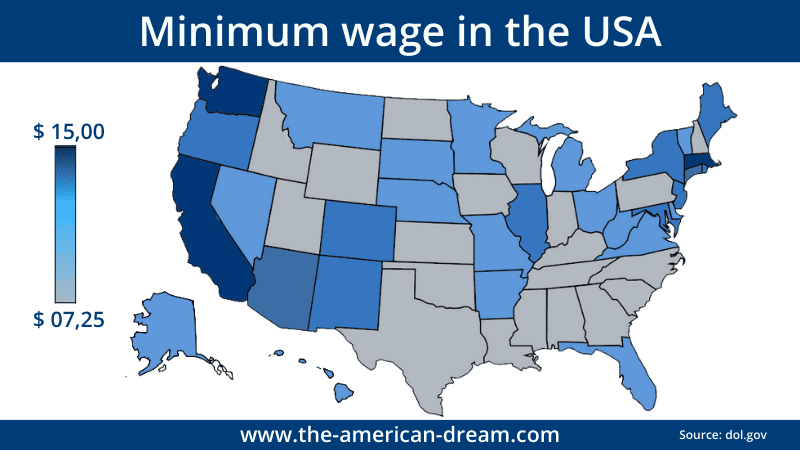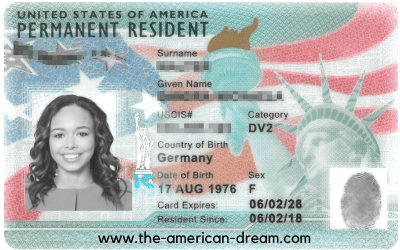- Immigrate to the USA
- Working in the USA
- Immigrate to the USA
- Working in the USA
Working in the USA
Do you want to work in the USA? If so, you should get to know the American work environment and its particular rules. Here's what is essential when starting a job in the USA and how to avoid mistakes with bosses, colleagues, business partners, and the US authorities.
- The American job market
- How much does one make in the USA?
- The minimum wage in the USA
- Working in the USA: pricey life with minimum wage?
- Work permit for the USA
- Which visa entitles you to work in the USA?
- The difference between a work visa and a Green Card
- Working in the USA without a work visa
- How to find a job in the USA?
- Jobs in the USA: finding the best positions
- Which professions are in demand in the USA?
- Employment contracts in the USA
- Salary payment in the USA
- Taxes and insurance when working in the USA
- Employment protection in the USA
- Maternity protection in the USA
- The number of vacation days in the USA
- Benefits of US employment contracts
- Working hours and overtime in the USA
- Employee duties in the USA
- Work culture in the USA
- 10 Tips for working in the USA
- Are you ready for your first day of work in the USA?
Take the chance of living in the USA and apply for the official US Green Card Lottery!
The American job market
Hard work, precise results, and facts will get you far in the American job market. This is already evident in the lean American application process, which calls for clearly structured spreadsheets and "short facts."
Suppose you are used to agonizingly long decision-making processes and endless meetings (lots of words, little content). In that case, you will be delighted by the refreshing dynamism of the American business world.
However, this straightforwardness is not without challenges: termination protection, paid sick leave, and parental leave aren't always part of American employment contracts. As an applicant in a US company, you must be prepared and negotiate well. The magic word is "benefits."
How much does one make in the USA?
The amount you will earn in your job in the United States depends largely on the industry, job title, US state, and skill level. Based on data from the new census, the average real household income in the United States in 2023 was $ 80,610. However, it is crucial to remember that these are national averages, and incomes can vary widely depending on where people live, their occupations, and their education.
Unfortunately, this average salary doesn't mean much because there are substantial salary differences across the US. Only one rule of thumb seems to apply across the board: the higher your education level, the higher your salary.
The minimum wage in the USA
The legal minimum wage varies in different US states. Top rates around $ 15 can be found in California, Washington, and Washington, D.C., while many other states implement the statewide minimum wage of $ 7.25.

Working in the USA: pricey life with minimum wage?
Many prospective US immigrants wonder how they will make ends meet on minimum wage in expensive US cities like New York City or San Francisco. It's no secret that many big-city residents work multiple jobs at once to afford the expensive rents.
However, policymakers are not blind to this problem either, so the legal minimum wages do not apply across the board. Employers in New York City, for example, must pay at least $ 15 an hour despite the federal minimum wage of about $ 13. San Francisco has a minimum salary of about $ 16, while the state of California is only set at about $ 15.
Work permit for the USA
You may not work in the American labor market without a visa. Therefore, obtaining the correct residence permit is the first and most crucial step to your job in the USA.
Which visa entitles you to work in the USA?
In the United States, different visa categories allow you to take up work:
- E-visa - trade or investments in the USA by foreign companies
- L-visa - employee assignment to a US branch office
- H-1B-visa - academics with job offers in high-demand professions
- Green Card - unlimited work authorization in all industries, occupations, and US states
While E-, L-, or H-1B-visas must be applied for by an employer, you can take care of getting a Green Card yourself: in the annual Green Card Lottery, the US government gives away 55,000 immigrant visas, which, if won, give you an unlimited right to live and work in the USA.
Other United States work visas include C-1/D visas for crew members, I visas for journalists, O visas for persons of exceptional ability in science, arts, education, business, sports, or media, and TN visas for Canadian or Mexican nationals.
Learn more about work visas for the USA
For detailed information on American work visas, check our US visa article.
The difference between a work visa and a Green Card
While US work visas are temporary and therefore not suitable for permanent residence in the US, holding a Green Card gives you unlimited permission to live and work in the States.
In addition, with a Green Card, you are free to choose both your employer and the US state to live and work. Thus, as a Green Card holder, you are neither dependent on a specific company nor visa extensions and arbitrary decisions by the authorities.
Working with a Green Card
If you already have a Green Card at the time of your job search in the USA, you will have a significant advantage over other applicants. There is no need for expensive and lengthy applications through the employer (e.g., immigration petition and Labor Certification) when hiring permanent residents.

Working in the USA without a work visa
Those who do not have a work visa, e.g., because they live in the USA as a family member of an expat, usually have to go through a lengthy application process for an EAD (Employment Authorization Document).
As of 2022, the US government announced an exception for spouses of E-visa or L-visa holders: in order to be allowed to work in the US, they now only need a legal residence status based on the new I-94 entry form.
What counts here is a new code on the form: the so-called COA code. With the identifier E-1S, E-2S, E-3S, or L-2S in the I-94 form, the spouse automatically has a work authorization for the validity period of his or her residence permit.
How to find a job in the USA?
The path to a new job in the USA, just like in most other countries, leads through a written (usually digital) application. The application process involves several steps:
- Visa clarification (ideally, apply for a Green Card)
- Find a job advertisement
- Send application documents
- Follow-up and contact management
- Job interview(s)
- Job confirmation
Do you need help with your application to a US company? Visit Job application in the USA for detailed instructions, clear examples, and professional advice.
Jobs in the USA: finding the best positions
Suppose you're not committed to a particular industry. In that case, it's best to keep an eye on the growth of various American economic sectors to secure a well-paying and sustainable job in the USA.
The so-called TIMES markets (telecommunications, information technology, multimedia, entertainment, and security services) are still experiencing a boom. Strong growth and desirable employers can be found in the following areas, for example:
- IT & Software Development
- Environmental engineering
- Mechanical engineering
- Banking
- Accounting
- Controlling
- Accounting
- Taxation
- Insurance
- Auditing
Which professions are in demand in the USA?
Education and social services, as well as medicine, are perennial top employment sectors in the USA. The absolute job guarantor, however, is still the service sector. The strongest pillar of the US economy employs around 80 % of the US workforce.
The most in-demand occupations in the United States in 2023, according to the U.S. Bureau of Labor Statistics, are:
- Wind turbine service technicians
- Nurse practitioners
- Data scientists
- Statisticians
- Information security analysts
- Medical and health services managers
- Epidemiologists
- Physician assistants
- Software developers
- Occupational therapy assistants
The shortage of skilled workers is starting to take hold in the United States, making the good old American Dream a reality again. Some companies are so desperate to find good employees that they are luring applicants with attractive bonuses and amenities. So don't hesitate to ask for generous "benefits" before accepting a new employment offer.
Employment contracts in the USA
The most distinctive feature of American employment contracts is that they often do not exist at all. To be more precise, the written form is not mandatory in the United States. Instead, the job's outline and benefits are often sent out as an offer and then accepted by the employee.
Salary payment in the USA
Salaries in the USA are usually not paid monthly, but weekly or bi-weekly. Payment can be made by paycheck or by bank transfer (deposit).
Taxes and insurance when working in the USA
Taxes and social security (including pension contributions) are generally deducted from the salary in the USA.
Employment protection in the USA
There is no legal protection against dismissal in the USA, which is why your job security is purely a matter of negotiation. In many companies, a notice period of two weeks is standard.
However, don't be put off by the apparent "hire and fire" mentality, as American companies have a vested interest in retaining qualified employees for the long term.
Maternity protection in the USA
In some US states, there is no legislated maternity protection. Therefore, as an employee with actual family plans, you should first learn the state regulations in your place of work and then start negotiating with your employer.
US states with comparatively good maternity protection rules include Hawaii, New Jersey, Connecticut, Oregon, Rhode Island, New York, Washington, D.C., and California (which even has paternity leave!)
If you live in a state with deficient or nonexistent maternity leave rules (e.g., Alabama, Mississippi, or Arizona), you as a mother may be allowed to take 12 weeks of unpaid leave at best, depending on the company. At worst, you may have to work through the entire pregnancy or resign.
Learn more about maternity leave in the USA in the Family and Medical Leave Act of 1993 (FMLA).
The number of vacation days in the USA
The exact number of vacation days in US companies depends largely on the company, the length of service, and an employee's negotiating skills. On average, full-time employees receive ten vacation days per year.
However, there are signs of a trend reversal in the American market. In particular, renowned technology companies and organizations with an increased shortage of skilled workers have recently been generous with vacation days.
Benefits of US employment contracts
A lack of protection against dismissal or a low salary can be compensated for with so-called benefits. These are additional perks that the employer and employee put together in a modular system until both sides are satisfied with the terms of the contract.
Possible benefits of American employment contracts are:
- Health insurance through the employer
- Pension plans
- More (and/or paid) vacation days
- Home office arrangements
- Training courses
- Health courses
- Flexible working hours
- Paid parental leave
- Sick pay / more sick days (medical leave)
- Profit-sharing, bonuses, stock options
The payment of Social Security contributions is part of the employer's obligation and is not a matter of negotiation.
Working hours and overtime in the USA
You usually work 40 hours per week in the USA in a full-time job. The way overtime must be handled specified by the Department of Labor (DOS) in the Fair Labor Standards Act (FLSA):
- Overtime must be compensated (exceptions may apply).
- The number of allowed overtime hours is not regulated by law.
- No special compensation is provided by law for work on weekends and holidays.
- Overtime must be compensated on the regular payday for the period in which it was worked.
However, these are only the minimum requirements for American employers. So there is plenty of room for improvement in your benefits negotiations. Depending on the size of the company and the US state, individual rules can be added or omitted (in the case of small companies.)
Employee duties in the USA
As an employee in the United States, you must show up for work on time and perform your work duties with the resources available. In addition, employee duties in the USA include:
- diligence in handling work materials and working hours
- honesty in dealing with the employer (do not steal, do not lie)
- the deduction of breaks from the calculated working time
- confidential treatment of internal company data and documents
- compliance with safety regulations
- compliance with anti-discrimination regulations
In larger companies, staff can often find a so-called "Code of Conduct" intended to ensure a peaceful working atmosphere. Please read this document thoroughly and internalize it at the beginning of employment.
Work culture in the USA
The culture in American companies can vary greatly depending on the industry and the job, but all American companies have one thing in common: a belief in success!
When working in the United States, you are measured by results and must be able to put clear facts and figures on the table. Having "tried" something to the best of your knowledge and belief will rarely be enough for your management.
On the other hand, your approach to success can be unusual: meetings on the golf course or the temporary "immersion" of individual employees for a creative break to achieve their goals are not uncommon.
Many companies have adopted the motto: "Work hard, play hard!”
10 Tips for working in the USA
The following rules for working in the United States will save you from putting your foot in your mouth and getting nasty surprises:
- Don't make raunchy jokes - no matter what the context! Accusations of sexual harassment lurk around every corner.
- Hold back on know-it-alls, even if colleagues and bosses are in the wrong. Even relentless honesty and vigorous backtalk are considered rude.
- Adhere to company rules on the use of computers, the Internet, telephone, and e-mail.
- Don't smoke (or only do it in specially designated places), and don't drink during work hours.
- Complete diversity training to learn appropriate ways to treat minorities and not inadvertently discriminate against anyone.
- Talk less, do more! Don't install long planning phases, but get started right away - always keep the goal or vision in mind!
- Do not openly display privileges or status symbols.
- Educate yourself autonomously in order to always be up to date in your field of work.
- Keep typical "Hi, how are you?" conversations short and casual. More engaging conversations take place outside of work hours.
- Instead of a "No!" always opt for a "Maybe!" or a "Good point, and also ..."
Dress code in American offices
In the USA, you should arrive at work dressed plain and neat (or in a clean uniform). If unsure, ask your supervisor or Human Resources what is considered appropriate in your company.
Are you ready for your first day of work in the USA?
Of course, you are! You wouldn't have ended up on this website if you hadn't already internalized the American mindset: anything is possible! Think positive!
When working in the USA, always keep your mind on the goal and pursue your vision. Then you will instinctively make the right decisions!


 DE
DE EN
EN ES
ES FR
FR PL
PL TR
TR UA
UA